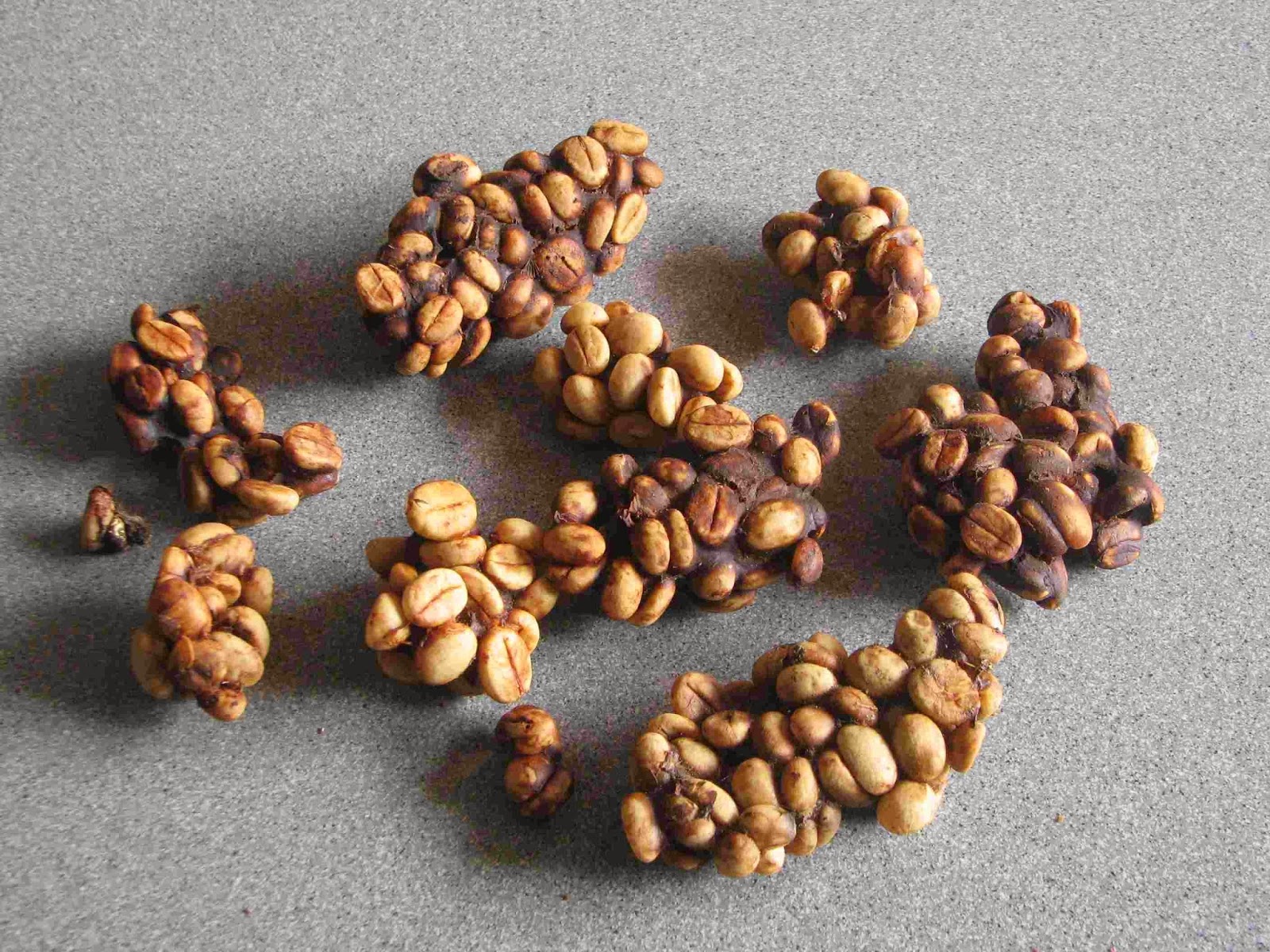Kopi luwak or civet espresso, alludes to the seeds of espresso berries once they have been consumed and crapped by the Asian palm civet (Paradoxurus hermaphroditus). The name is likewise utilized for promoting blended espresso produced using the beans.
Makers of the espresso beans contend that the procedure may enhance espresso through two instruments, determination and processing. Choice happens if the civets decide to consume espresso berries containing better beans. Digestive instruments may enhance the flavor profile of the espresso beans that have been consumed. The civet consumes the berries for the beans' meaty mash, then in the digestive tract, maturation happens. The civet's Protease compounds saturate the beans, making shorter peptides and all the more free amino acids. Going through a civet's digestion tracts the beans are then pooped with other fecal matter and gathered.
The conventional technique for gathering defecation from wild civets has offered approach to serious cultivating strategies in which civets in battery confine frameworks are power nourished the espresso beans. This technique for generation has raised moral worries about the treatment of civets because of "horrific conditions" including separation, poor eating methodology, little enclosures and a high death rate. A 2013 BBC examination of concentrated civet cultivating in Sumatra discovered states of creature remorselessness. Serious cultivating is likewise scrutinized by conventional agriculturists in light of the fact that the civets don't select what they consume, so the beans are of low quality contrasted with beans gathered from nature. As indicated by an officer from the TRAFFIC protection program, the exchange civets to make kopi luwak may constitute a huge danger to wild civet populaces.
Despite the fact that kopi luwak is a manifestation of preparing as opposed to an assortment of espresso, it has been called a standout amongst the most costly espressos the world with retail costs arriving at €550/ US$700 every kilogram, near to the €850/ US$1,100 cost of Black Ivory espresso. The value paid to authorities in the Philippines is closer to US$20 every kilogram. The cost of cultivated (considered second rate by experts) kopi luwak in expansive Indonesian markets is from US$100 every kilogram (five times the cost of an amazing neighborhood arabica espresso). Real kopi luwak from wild civets is hard to buy in Indonesia and demonstrating it is not fake is exceptionally troublesome - there is little authorization with respect to utilization of the name "kopi luwak", and there's even a neighborhood modest espresso brand named "Luwak", which costs under US$3 every kilogram except is at times sold online under the pretense of genuine kopi luwak.
An examination by People for the Ethical Treatment of Animals (PETA) Asia discovered extortion to be overflowing in the kopi luwak industry, with makers eager to name espresso from confined civets with a "wild sourced" or comparable mark. A BBC examination uncovered comparative discoveries.
Kopi luwak is delivered chiefly on the islands of Sumatra, Java, Bali and Sulawesi in the Indonesian Archipelago. It is additionally broadly accumulated in the backwoods or created in the homesteads in the islands of the Philippines (where the item is called kape motit in the Cordillera area, kape alamid in Tagalog territories, and kape melô or kape musang in Mindanao island), and in East Timor (where it is called kafé-laku). Weasel espresso is a detached English interpretation of its Vietnamese name cà phê Chồn, where prominent, synthetically mimicked renditions are likewis
Teste
Few target evaluations of taste are accessible. Kopi luwak is a name for any beans gathered from the fecal matter of civets, consequently the taste may shift with the sort and starting point of beans ingested, transforming consequent to accumulation, simmering, maturing and preparing. The capacity of the civet to choose its berries, and different parts of the civet's eating methodology and wellbeing (e.g. anxiety levels) might likewise impact the handling and thus taste.
In the espresso business, kopi luwak is generally viewed as a trick or trinket. The Specialty Coffee Association of America (SCAA) states that there is a "general accord inside the business ... it simply tastes terrible". An espresso expert refered to in the SCAA article had the capacity contrast the same beans and without the kopi luwak procedure utilizing a thorough espresso measuring assessment. He finished up: "it was obvious that Luwak espresso sold for the story, not unrivaled quality...Using the SCAA measuring scale, the Luwak scored two focuses underneath the least of the other three espressos. No doubt the Luwak transforming lessens great causticity and season and adds smoothness to the body, which is the thing that numerous individuals appear to note as a positive to the espresso."
Tim Carman, nourishment author for the Washington Post surveyed kopi luwak accessible to US customers and finished up "It tasted simply like...Folgers. Stale. Motionless. Petrified dinosaur droppings saturated with bathtub water. I couldn't complete it."
A few faultfinders assert all the more for the most part that kopi luwak is essentially awful espresso, acquired for curiosity as opposed to taste. Massimo Marcone, who performed far reaching concoction tests on the beans, was not able to finish up if anything about their properties made them unrivaled for purposes of making espresso. He utilized a few expert espresso tasters (called "cuppers") in a visually impaired taste test. While the cuppers had the capacity recognize the kopi luwak as different from alternate examples, they don't had anything amazing to assess about it other than it was less acidic and had less body, tasting "slight". Marcone commented "It isn't so much that individuals are after that different flavor. They are after the uncommonness of the espresso".










